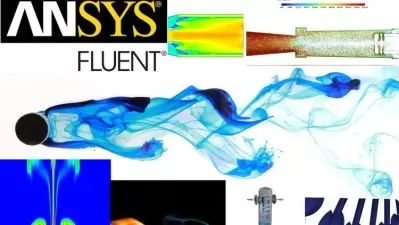NREL 5 MW Wind Turbine : CFD Analysis with Validation
Sijal Ahmed
3:47:27
Description
Expert CFD Analysis of Wind Turbines: Advanced Simulation Techniques and Validation with ANSYS Fluent
What You'll Learn?
- Students will grasp the fundamentals of CFD modeling specifically for wind turbines.
- Participants will create high-quality CFD meshes that accurately resolve boundary layers and provide fine detail in critical areas.
- Students will set up and execute simulations in Fluent, optimizing settings for wind turbine applications.
- Participants will perform post-processing of results in both Fluent and CFD Post, validating their findings against experimental data from NREL
Who is this for?
What You Need to Know?
More details
DescriptionThis course offers a comprehensive and in-depth exploration of computational fluid dynamics (CFD) as it applies to the analysis of a 5 MW wind turbine, a vital component in harnessing wind power for sustainable electricity generation. In 2023, wind energy contributed approximately 7.81% of global electricity production, underscoring the critical need for efficient turbine design in today’s renewable energy landscape. Using the Dutch Offshore Wind Energy Converter (DOWEC) 6 MW turbine as a reference, students will learn the complete CFD process, encompassing everything from geometry preparation to final results validation.
Participants will start by defining the computational domain through the import of their SolidWorks models into SpaceClaim. They will utilize a watertight workflow to generate a high-quality mesh in Fluent Meshing, which is essential for accurate simulations. This foundational work will prepare them for conducting detailed simulations in ANSYS Fluent, where they will analyze turbine performance under specific operational conditions, including an inlet velocity of 11.4 m/s and a rotational speed of 12.1 RPM. With an impressive simulation error margin of only 0.3%, students will cultivate valuable skills in result validation and learn how to interpret aerodynamic performance metrics effectively.
By the end of the course, students will have mastered advanced CFD techniques specifically tailored for large wind turbines. This hands-on experience will empower them to tackle real-world challenges in turbine design and optimization, equipping them with the knowledge and skills necessary to contribute meaningfully to the renewable energy sector. Graduates of this course will be well-prepared to pursue impactful careers in engineering, research, and innovation in the field of sustainable energy.
Who this course is for:
- This course is designed for engineering students, recent graduates, and professionals in the fields of mechanical, aerospace, or renewable energy engineering who are interested in enhancing their skills in computational fluid dynamics (CFD) specifically for wind turbine analysis. It is ideal for those looking to deepen their understanding of turbine design and optimization, as well as for researchers and engineers involved in renewable energy projects. Additionally, anyone aiming to advance their expertise in CFD tools like ANSYS Fluent will find this course beneficial.
This course offers a comprehensive and in-depth exploration of computational fluid dynamics (CFD) as it applies to the analysis of a 5 MW wind turbine, a vital component in harnessing wind power for sustainable electricity generation. In 2023, wind energy contributed approximately 7.81% of global electricity production, underscoring the critical need for efficient turbine design in today’s renewable energy landscape. Using the Dutch Offshore Wind Energy Converter (DOWEC) 6 MW turbine as a reference, students will learn the complete CFD process, encompassing everything from geometry preparation to final results validation.
Participants will start by defining the computational domain through the import of their SolidWorks models into SpaceClaim. They will utilize a watertight workflow to generate a high-quality mesh in Fluent Meshing, which is essential for accurate simulations. This foundational work will prepare them for conducting detailed simulations in ANSYS Fluent, where they will analyze turbine performance under specific operational conditions, including an inlet velocity of 11.4 m/s and a rotational speed of 12.1 RPM. With an impressive simulation error margin of only 0.3%, students will cultivate valuable skills in result validation and learn how to interpret aerodynamic performance metrics effectively.
By the end of the course, students will have mastered advanced CFD techniques specifically tailored for large wind turbines. This hands-on experience will empower them to tackle real-world challenges in turbine design and optimization, equipping them with the knowledge and skills necessary to contribute meaningfully to the renewable energy sector. Graduates of this course will be well-prepared to pursue impactful careers in engineering, research, and innovation in the field of sustainable energy.
Who this course is for:
- This course is designed for engineering students, recent graduates, and professionals in the fields of mechanical, aerospace, or renewable energy engineering who are interested in enhancing their skills in computational fluid dynamics (CFD) specifically for wind turbine analysis. It is ideal for those looking to deepen their understanding of turbine design and optimization, as well as for researchers and engineers involved in renewable energy projects. Additionally, anyone aiming to advance their expertise in CFD tools like ANSYS Fluent will find this course beneficial.
User Reviews
Rating
Sijal Ahmed
Instructor's Courses
Udemy
View courses Udemy- language english
- Training sessions 11
- duration 3:47:27
- Release Date 2024/12/24











